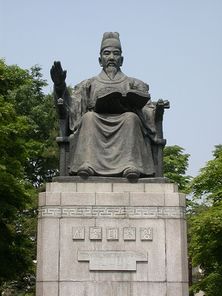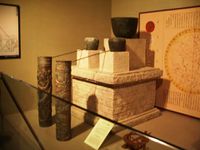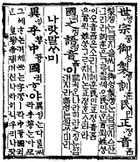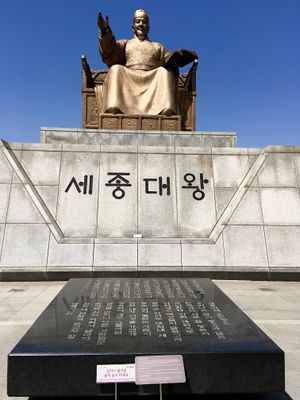سىجونگ الأكبر
| Sejong the Great 세종대왕 | |||||||||
|---|---|---|---|---|---|---|---|---|---|
 التمثال البرونزي للملك سىجونگ الأكبر في قصر دوكسو | |||||||||
| ملك جوسون | |||||||||
| العهد | 1418–1450 | ||||||||
| التتويج | 18 سبتمبر 1418 (aged 21) | ||||||||
| سبقه | Taejong of Joseon | ||||||||
| تبعه | Munjong of Joseon | ||||||||
| الوصي | Taejong of Joseon as Former King (1418–1422) Munjong of Joseon as Crown Prince (1444–1450) | ||||||||
| وُلِد | 7 May 1397 Hanseong، مملكة جوسون[1] | ||||||||
| توفي | 8 أبريل 1450 (aged 52) Hanseong، جوسون | ||||||||
| Consort | Queen Soheon | ||||||||
| الأنجال | Munjong of Joseon سىجو من جوسون | ||||||||
| |||||||||
| البيت | جونجو يي | ||||||||
| الأب | Taejong of Joseon | ||||||||
| الأم | Queen Wongyeong | ||||||||
| الديانة | الكونفوشية؛ ولاحقاً البوذية | ||||||||
| الاسم الكوري | |
 "سىجونگ" بالحروف الصينية | |
| هانگول | 세종대왕 |
|---|---|
| هانچا | 世宗大王 |
| الرومنة المعدلة | Sejong Daewang |
| مكيون-رايشاور | Sechong Taewang |
| اسم الميلاد | |
| هانگول | 이도 |
| هانچا | 李祹 |
| الرومنة المعدلة | I Do |
| مكيون-رايشاور | I To |
| اسم الطفولة | |
| هانگول | 원정 |
| هانچا | 元正 |
| الرومنة المعدلة | Won Jeong |
| مكيون-رايشاور | Wŏn Chŏng |
سىجونگ الأكبر (النطق الكوري: [se(ː)dʑoŋ]؛ إنگليزية: Sejong the Great؛ 7 مايو 1397 – 8 أبريل 1450) كان رابع ملوك أسرة جوسون في كوريا. He was the third son of King Taejong and Queen consort Min. He was designated as heir-apparent, Crown Prince, after his older brother Prince Yangnyeong was stripped of his title. He ascended to the throne in 1418. During the first four years of his reign, Taejong governed as regent, after which his father-in-law, Sim On, and his close associates were executed.
Sejong reinforced Confucian policies and executed major "legal amendments" (공법; 貢法). He also personally created and promulgated the Korean alphabet Hangul,[2][3] encouraged advancements of scientific technology, and instituted many other efforts to stabilize and improve prosperity. He dispatched military campaigns to the north and instituted the Samin policy (사민정책; 徙民政策) to attract new settlers to the region. To the south, he subjugated Japanese pirates and captured Tsushima Island (also known as Daema Island in the Korean language).
During his reign from 1418 to 1450, he governed along with his father, the King Emeritus Taejong from 1418 to 1422, then governing as the sole monarch from 1422 to 1450. Since 1442, the king was increasingly ill so his son Crown Prince Munjong acted as regent for him.
Although the appellation "the Great" / "(대왕;大王)" was given posthumously to almost every ruler of Goryeo and Joseon, this title is usually associated with Gwanggaeto and Sejong.
. . . . . . . . . . . . . . . . . . . . . . . . . . . . . . . . . . . . . . . . . . . . . . . . . . . . . . . . . . . . . . . . . . . . . . . . . . . . . . . . . . . . . . . . . . . . . . . . . . . . . . . . . . . . . . . . . . . . . . . . . . . . . . . . . . . . . . . . . . . . . . . . . . . . . . . . . . . . . . . . . . . . . . . .
الحياة
الإنجازات
العلوم والتكنولوجيا والزراعة

Sejong is credited with great advances in science during his reign.[4][5] He wanted to help farmers so he decided to create a farmer's handbook. The book—the Nongsa jikseol (hangul: 농사직설, hanja: 農事直說)—contained information about the different farming techniques that he told scientists to gather in different regions of Korea.[6] These techniques were needed in order to maintain the newly adopted methods of intensive, continuous cultivation in Korean agriculture.[6]

Sejong also wanted to reform the Korean calendar system, which was at the time based upon the longitude of the Chinese capital.[6] Sejong, for the first time in Korean history, had his astronomers create a calendar with the Joseon capital of Seoul as the primary meridian.[6] This new system allowed Korean astronomers to accurately predict the timing of solar and lunar eclipses.[6][7]
In the realm of traditional Korean medicine, two important treatises were written during the reign of Sejong. These were the Hyangyak jipseongbang and the Euibang yuchwi, which historian Kim Yongsik says represents 'Koreans' efforts to develop their own system of medical knowledge, distinct from that of China.'[6]
هانگول

King Sejong the Great profoundly affected Korean history with his personal creation and introduction of hangul, the native phonetic writing system for the Korean language.[3][8]
الوفاة والذكرى
العائلة
- Father: King Taejong of Joseon (13 June 1367 – 30 May 1422) (조선 태종)
- Grandfather: King Taejo of Joseon (27 October 1335 – 18 June 1408) (조선 태조)
- Grandmother: Queen Shinui of the Anbyeon Han clan (September 1337 – 21 October 1391) (신의왕후 한씨)
- Mother: Queen Wongyeong of the Yeoheung Min clan (11 July 1365 – 10 July 1420) (원경왕후 민씨)
- Grandfather: Min Je (1339 – 1408) (민제)
- Grandmother: Lady Song of the Yeosan Song clan (1342 – 1424) (여산 송씨)
- Consorts and their Respective Issue(s):
- Queen Soheon of the Cheongsong Shim clan (12 October 1395 – 19 April 1446) (소헌왕후 심씨)[9][10]
- Princess Jeongso (1412 – 25 February 1424) (정소공주)[11]
- Yi Hyang, Crown Prince Hyang (15 November 1414 – 1 June 1452) (왕세자 향)
- Princess Jeongui (1415 – 11 February 1477) (정의공주)[12]
- Yi Yu, Grand Prince Suyang (2 November 1417 – 23 September 1468) (이유 수양대군)
- Yi Yong, Grand Prince Anpyeong (18 October 1418 – 18 November 1453) (이용 안평대군)
- Yi Gu, Grand Prince Imyeong (6 January 1420 – 21 January 1469) (이구 임영대군)
- Yi Yeo, Grand Prince Gwangpyeong (2 May 1425 – 7 December 1444) (이여 광평대군)
- Yi Yu, Grand Prince Geumseong (5 May 1426 – 7 November 1457) (이유 금성대군)
- Yi Im, Grand Prince Pyeongwon (18 November 1427 – 16 January 1445) (이임 평원대군)
- Yi Yeom, Grand Prince Yeongeung (23 May 1434 – 2 February 1467) (이염 영응대군)
- Royal Noble Consort Yeong of the Jinju Kang clan (영빈 강씨)[13]
- Yi Yeong, Prince Hwaui (1425 – 1460) (이영 화의군)
- Royal Noble Consort Shin of the Cheongju Kim clan (1406 – 4 September 1464) (신빈 김씨)[14][15]
- Yi Jeung, Prince Gyeyang (1427 – 16 August 1464) (이증 계양군)[16]
- Yi Gong, Prince Uichang (1428 – 1460) (이공 의창군)
- Yi Chim, Prince Milseong (1430 – 1479) (이침 밀성군)
- Yi Yeon, Prince Ikhyeon (1431 – 1463) (이연 익현군)
- Yi Dang, Prince Yeonghae (1435 – 1477) (이당 영해군)
- Yi Geo, Prince Damyang (1439 – August 1450) (이거 담양군)
- 2 Unnamed daughters who died at childbirth
- Royal Noble Consort Hye of the Cheongju Yang clan (? – 9 November 1455) (혜빈 양씨)[17][18]
- Yi Eo, Prince Hannam (5 October 1429 – 29 June 1459) (이어 한남군)
- Yi Hyeon, Prince Suchun (1431 – 1455) (이현 수춘군)
- Yi Jeon, Prince Yeongpung (17 September 1434 – 22 July 1456) (이전 영풍군)
- Royal Consort Gwi-in of the Miryang Park clan (귀인 박씨)[19]
- Royal Consort Gwi-in of the Choi clan (귀인 최씨)[20]
- Royal Consort Suk-ui of the Jo clan (숙의 조씨)
- Royal Consort So-yong of the Hong clan (? – 4 February 1452) (소용 홍씨)
- Royal Consort Suk-won of the Lee clan (숙원 이씨)
- Princess Jeongan (1438 – 16 October 1461) (정안옹주)[21]
- Consort Sang-chim of the Song clan(1396-1463) (상침 송씨)
- Princess Jeonghyeon (1425 – November 1480) (정현옹주)[22]
- Consort Sa-gi of the Cha clan (? – 10 July 1444) (사기 차씨)
- An unnamed daughter (1430 – 1431)
- Lady Sangsik of the Hwang clan (상식 황씨)
- Lady Jeonchan of the Park clan (전찬 박씨)
ألقاب بعد الموت الرسمية


- Hanja: 世宗莊憲英文睿武仁聖明孝大王
- Hangul: 세종장헌영문예무인성명효대왕
- English: King Sejong Jangheon Yeongmun Yemu Inseong Myeonghyo the Great
تصويره في الفنون والإعلام
- Portrayed by Kim Sang-kyung in the 2008 KBS2 TV series King Sejong the Great and in the 2016 KBS1 TV series Jang Yeong-sil.
- Portrayed by Lee Hyun-woo in the 2008 KBS2 TV series King Sejong the Great.
- Portrayed by Ahn Sung-ki in the 2008 film The Divine Weapon.
- Portrayed by Jeon Moo-song in the 2011 JTBC TV series Insu, The Queen Mother.
- Portrayed by Han Suk-kyu, Song Joong-ki and Kang San in the 2011 SBS TV series Deep Rooted Tree.
- Portrayed by Ju Ji-hoon in the 2012 film I Am the King.
- Portrayed by Yoon Doo-joon in the 2015 MBC TV series Splash Splash Love.
تصويرات في ألعاب الڤيديو
- Leader of the Korean civilization in Sid Meier's Civilization V
- Leader of the Korean civilization in Civilization Revolution 2
- King Sejong Station LE, a major tournament map in the game StarCraft II: Heart of the Swarm[23]
- Starting ruler of Korea in Europa Universalis IV
. . . . . . . . . . . . . . . . . . . . . . . . . . . . . . . . . . . . . . . . . . . . . . . . . . . . . . . . . . . . . . . . . . . . . . . . . . . . . . . . . . . . . . . . . . . . . . . . . . . . . . . . . . . . . . . . . . . . . . . . . . . . . . . . . . . . . . . . . . . . . . . . . . . . . . . . . . . . . . . . . . . . . . . .
الپورتريه على الأوراق النقدية الكورية
Sejong the Great is one of the six linguistic scholars, with Samuel Johnson,[24] Jacob Grimm, Wilhelm Grimm, Elias Lönnrot, and Vuk Stefanović Karadžić depicted as a portrait in a national currency.
التمثال والمعرض بالمتحف
A 9.5 meter high bronze statue of King Sejong was placed in 2009 on a concrete pedestal on the boulevard of ميدان گوانگهوامون and directly in front of the Sejong Center for the Performing Arts in Seoul.[25] The sculptor was Kim Young-won.[26] The pedestal contains one of several entrances to the 3,200 square meter, underground museum exhibit entitled "The Story of King Sejong".[27][28] It was dedicated on Hangul Day in celebration of the 563rd anniversary of the invention of the Korean alphabet by King Sejong.[29]
See also
| Sejong the Great
]].- List of Korea-related topics
- History of Korea
- Rulers of Korea
- Sejongno
- Sejong the Great class destroyer
- Sejong Center
- King Sejong Station
- UNESCO King Sejong Literacy Prize
- Sejong City
References
- ^ في غرفة JoonSoo (준수방; 俊秀坊)
- ^ Kim-Renaud, Young-Key (1997). The Korean Alphabet: Its History and Structure (in الإنجليزية). University of Hawaii Press. p. 15. ISBN 9780824817237. Retrieved 16 May 2018.
- ^ أ ب "알고 싶은 한글". 국립국어원. National Institute of Korean Language. Retrieved 4 December 2017.
- ^ Haralambous, Yannis; Horne, P. Scott (2007-11-28). Fonts & Encodings (in الإنجليزية). "O'Reilly Media, Inc.". p. 155. ISBN 9780596102425. Retrieved 8 October 2016.
- ^ Selin, Helaine (2013-11-11). Encyclopaedia of the History of Science, Technology, and Medicine in Non-Westen Cultures (in الإنجليزية). Springer Science & Business Media. pp. 505–506. ISBN 9789401714167. Retrieved 27 July 2016.
- ^ أ ب ت ث ج ح Kim (1998), 57.
- ^ https://web.archive.org/web/20180629022148/http://www.reportnet.co.kr/knowledge/pop_preview.html?dn=2075262. Archived from the original on 29 June 2018. Retrieved 25 October 2008.
{{cite web}}: Missing or empty|title=(help); Unknown parameter|dead-url=ignored (|url-status=suggested) (help) - ^ Kim Jeong Su(1990), <<한글의 역사와 미래>>(History and Future of Hangul) ISBN 8930107230
- ^ Daughter of Sim On (심온, 1375 – 25 December 1418), Lord Anhyo (안효공), Internal Prince Cheongcheon (청천부원군); and Lady Sunheung, Princess Consort to the Internal Prince, of the Ahn clan (순흥부부인 안씨). Granddaughter of Sim Deok-bu (심덕부, 1328–1401)
- ^ Her uncle Sim Jong (Sim On's brother) is Taejo's son-in-law (created Prince Consort Cheongwon) thru his marriage to Princess Gyeongseon
- ^ Eldest offspring
- ^ Later married Ahn Maeng-dam (안맹담, ?–1469), son of Ahn Mang-ji (안망지); created Military Officer Yeonchang (연창위)
- ^ Daughter of Gang Seok-deok (강석덕) and Sim On's 2nd daughter (심씨; Queen Soheon's younger sister), making her Queen Soheon's niece
- ^ Daughter of Kim Won (김원)
- ^ Originally a slave of Naeja Temple (내자사 內資寺), and became a palace girl in 1418, under Queen Wong-yeong, and later under Queen So-heon
- ^ Later married Han Hwak (한확)'s 2nd daughter (Lady Jeongseon, Princess Consort (정선군 부인)), elder sister to the future Queen So-hye
- ^ Daughter of Yang Gyeong (양경) and Lady Lee (이씨). Granddaughter of Yang Cheom-sik (양첨식) and great-granddaughter of Yang Ji-su (양지수)
- ^ Given the temple name "Lady Minjeong" (민정) in 1791
- ^ Also known by her lesser title "Lady Jang-ui" (장의궁주), granted in 1424. Gwi-in status was granted in 1428
- ^ Also known by her lesser title "Lady Myeong-ui" (명의궁주), granted in 1424. Gwi-in status was granted in 1428
- ^ Later married Sim An-ui (심안의), created Military Officer Cheongseong (청성위)
- ^ Later married Yun Sa-ro (윤사로, 1423–1463), son of Yun Eun (윤은); created Internal Prince Yeongcheon (영천부원군)
- ^ "The King Sejong Station - Liquipedia - The StarCraft II Encyclopedia". Wiki.teamliquid.net. Retrieved 2016-02-22.
- ^ "Language Log » More linguistic numismatics". Languagelog.ldc.upenn.edu. Retrieved 2016-02-22.
- ^ "King Sejong Statue (세종대왕 동상) | Official Korea Tourism Organization". English.visitkorea.or.kr. Retrieved 2016-02-22.
- ^ "King Sejong and General Lee Sun-shin to receive modeling fee :: Korea.net : The official website of the Republic of Korea". Korea.net. 2011-12-09. Retrieved 2016-02-22.
- ^ "King Sejong Story (세종이야기) | Official Korea Tourism Organization". English.visitkorea.or.kr. Retrieved 2016-02-22.
- ^ "Remembering Hangul". Joongnag Daily. 26 September 2009. Archived from the original on 11 April 2013. Retrieved 27 February 2013.
{{cite news}}: Unknown parameter|dead-url=ignored (|url-status=suggested) (help) - ^ "Statue of King Sejong is unveiled". Joongang Daily. أكتوبر 10, 2009. Archived from the original on أبريل 11, 2013. Retrieved فبراير 27, 2013.
{{cite news}}: Unknown parameter|deadurl=ignored (|url-status=suggested) (help)
للاستزادة
- Kim, Yung Sik. (1998). "Problems and Possibilities in the Study of the History of Korean Science," Osiris (2nd series, Volume 13, 1998): 48–79.
- King Sejong the Great: the Light of Fifteenth Century Korea, Young-Key Kim-Renaud, International Circle of Korean Linguistics, 1992, softcover, 119 pages, ISBN 1-882177-00-2
- Kim-Renaud, Young-Key. 2000. Sejong's theory of literacy and writing. Studies in the Linguistic Sciences 30.1:13–46.
- Gale, James Scarth. History of the Korean People Annotated and introduction by Richard Rutt. Seoul: Royal Asiatic Society, 1972..
وصلات خارجية
- King Sejong's Confucian Humanism in the Early Choson Period
- Location of the four forts and the six posts
- King Sejong featured on the 10000 Korean Won banknote.
- King Sejong the Great: The Everlasting Light of Korea.
سىجونگ الأكبر وُلِد: 6 May 1397 توفي: 18 May 1450
| ||
| ألقاب ملكية | ||
|---|---|---|
| سبقه Taejong |
King of Joseon 1418–1450 مع Taejong (1418–1422) Munjong (1442–1450) |
تبعه Munjong |
خطأ لوا في package.lua على السطر 80: module 'Module:Authority control/auxiliary' not found.
- Articles containing كورية-language text
- CS1 errors: unsupported parameter
- CS1 errors: missing title
- CS1 errors: bare URL
- Short description is different from Wikidata
- Articles containing إنگليزية-language text
- Pages using Lang-xx templates
- Articles with hatnote templates targeting a nonexistent page
- Sejong the Great
- Joseon rulers
- Linguists from Korea
- Korean Buddhists
- Creators of writing systems
- 1397 births
- 1450 deaths
- 15th-century Korean monarchs
- وفيات بالسكري
